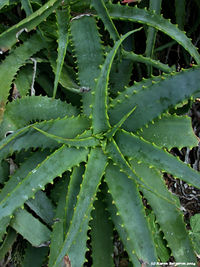Aloe vera
| See Also | Botanical Monographs |
|---|
| Article | Aloe Vera Gel Research Review, NMJ, [1], 2012 September |
|---|
Aloe (Aloe vera) has been used for the treatment of burns for centuries. To explore the characteristics, medicinal uses and prescribing considerations of this herb in more detail, check out the references indicated. [1] [2]
Contents
Characteristics
- Common Names: Aloe
- Family: Liliaceae
- Habitat: Aloe vera is native to Africa and grows in the wild tropics. It is now cultivated worldwide.
- Parts Used: Aloe vera - clear mucilaginous gel from the inner portion of the leaves; Aloes - bitter juice from the rind found at the base of the leaves
- Although Aloe vera and Aloes come from the same plant, they will be described separately as they have very distinct actions on the body.
- Constituents: Aloe vera gel - polysaccharides; Aloes - anthraquinones
- Medicinal Actions: vulnerary, emollient, antibacterial, anti-inflammatory, cholagogue, hepatic, laxative, bitter, choleretic, immune enhancing (locally), antihelmintic, antimicrobial
Uses
Historical Uses
Aloe vera was traditionally used as a skin lotion and was known to the Greeks since the 4th century. It has been used as a vulnerary for burns, particularly radiation burns since the 1950s.
Medicinal Uses
External (gel and juice)
Internal
- Digestive Conditions: peptic ulcers, irritable bowel syndrome
- Cardiovascular Conditions: varicose veins (to some extent)
- To Soften Stool: with anal fissures, following anal surgery, constipation (juice is a laxative)
- Bitter
Prescribing Considerations
The information provided is intended to augment the treatment from a naturopathic doctor or other trained medical professional. Although most herbs are generally safe, it is recommended that you avoid self-prescribing especially when there is an underlying ongoing medical condition, if you are on any prescription medications or if you are pregnant or breastfeeding.
- Avoid using aloe juice for more than weeks continuously.
Formulations and Preparation
External
- leaf sap (split leaf and apply gel); potted plants, low in anthraquinones, are better suited for external use
Internal
- Bitter - 1-3mL tincture before meals
- Laxative tincture - 2-8mL (1:40, 45%)
- Powder - 50-200mg at bedtime
- Low doses of bitter - digestive stimulant
- High doses of bitter - laxative, purgative
- Combine with carminative to reduce griping
Safety
The safety and prescribing considerations for this herb include: [3] [4]
- Generally regarded as safe.
- Side-effects may include:
- Rare allergic-type reactions may occur when using Aloe vera gel products often due to other ingredients in the product.
- When taken internally it may cause severe abdominal cramping, reversible pigmentation of colonic mucosa, urine discolouration, nephritis, gastritis, vomiting, bloody diarrhea, watery diarrhea.
- Contraindications:
- Aloe vera gel: known allergy (external); external use on surgical wounds healing by second intention with slower healing time; trace anthraquinone glycosides may be of concern in pregnancy and lactation (internal)
- Aloes: pregnancy and menstruation, menorrhagia and metrorrhagia; appendicitis and abdominal pain of unknown origin; not recommended for treatment of chronic constipation or diarrhea associated with bowel irritability; in the presence of hemorrhoids; intestinal obstruction; kidney disorders; children <12 years of age (water and electrolyte depletion); prolonged use > 8-10 days (lost peristalsis)
- Caution
- With chronic use or misuse - may cause mineral depletion, especially hypokalemia (low potassium)
- Drug-Herb Interactions.
- Chemotherapy and Radiotherapy Associated with Mucositis, Including Bleomycin, Fluorouracil, and Methotrexate - Potential or theoretical beneficial or supportive interaction with professional management, prevention or reduction of drug adverse effect; Gel may ameliorate chemo-induced oral and gastrointestinal mucositis. Use prophylactically and symptomatically.
- Surgery and Other Wound Care - Beneficial or supportive interaction with professional management; Gel incorporated into conventional dressings improves healing in wound care settings; Commercial hydrogel dressings available.
- Glyburide - Additive hypoglycemic effect (aloe juice)
- Hydrocortisone Acetate - Improves anti-inflammatory effect (gel)
- Antiarrhythmic Drugs and Cardiac Glycosides - Overuse or misuse of leaf sap (bitter aloes) may cause hypokalemia, leading to increased toxicity of the drugs.
- Thiazide Diuretics, Corticosteriods, and Licorice - Leaf sap (bitter aloes) aggravates potassium depletion caused by these drugs
- Oral Drugs in General - Leaf sap (bitter aloes) reduces absorption by reducing bowel transit time
References
- ↑ Boon Heather, Smith Michael (2009) 55 Most Common Medicinal Herbs: The Complete Natural Medicine Guide Second Edition Institute of Naturopathic Education and Research, CCNM Toronto.
- ↑ Godfrey Anthony, Saunders Paul, Barlow Kerry, Gowan Matt (2011) Principles and Practices of Naturopathic Botanical Medicine, Advanced Botanical Medicine. V3 CCNM Press, Toronto
- ↑ Stargrove Mitchell Bebell, Treasure Jonathan, McKee Dwight L (2008) Herb, Nutrient and Drug Interactions: Clinical Implications and Therapeutic Strategies
- ↑ Brinker Francis (2010) Herbal Contraindications and Drug Interactions: Plus Herbal Adjuncts With Medicines, 4th Edition Eclectic Medical Publications.
